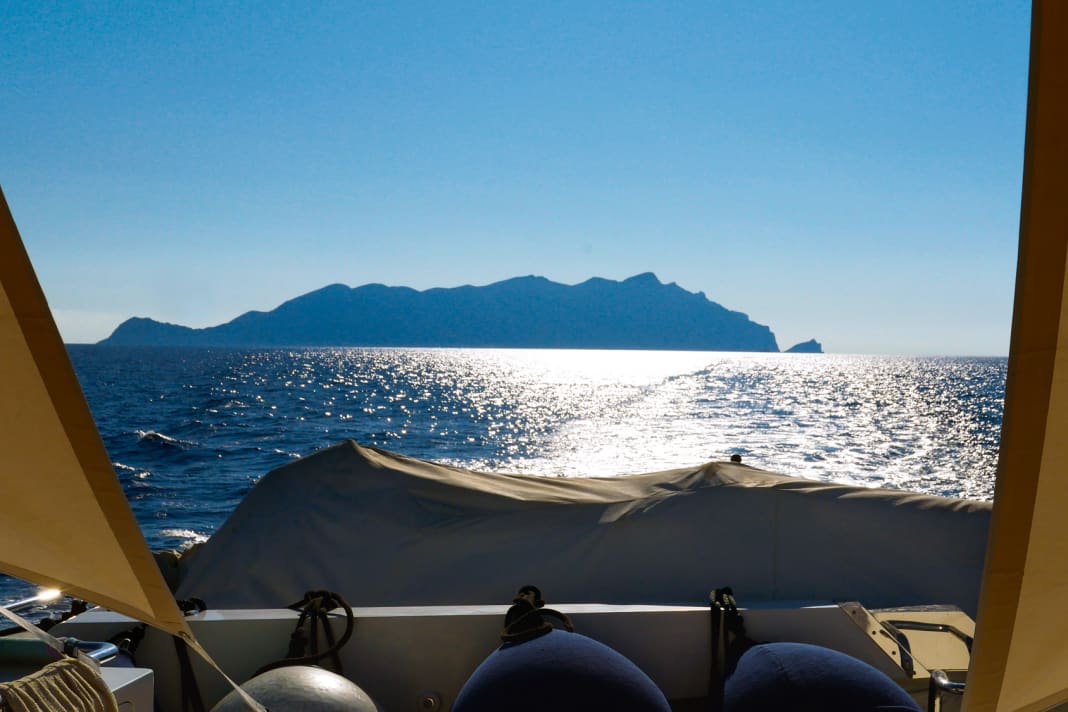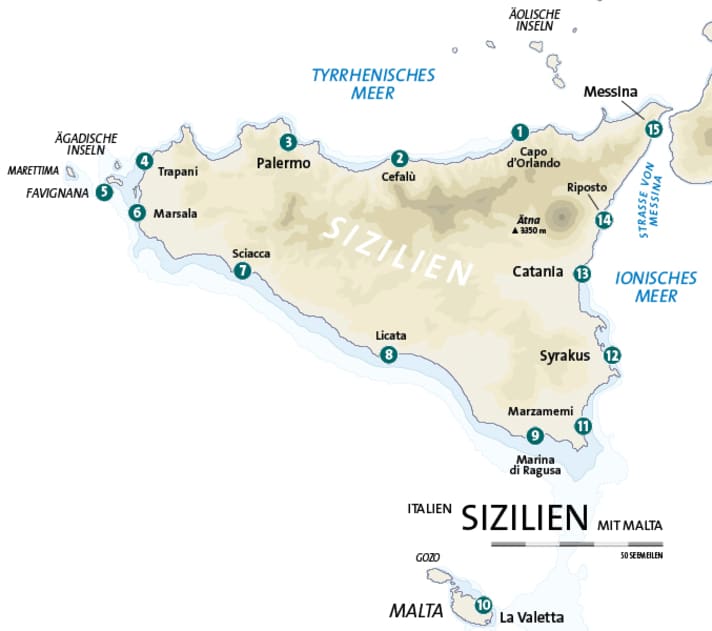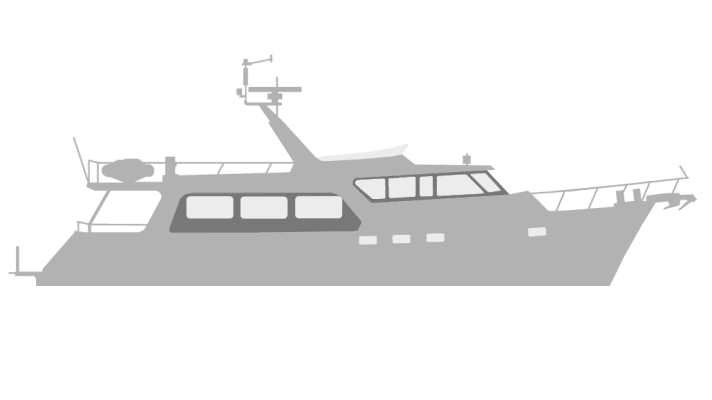





Welcome to the true south! On our summer voyage around Italy this year, "Azura" has arrived at the tip of the boot. We have already left the mainland in our wake for a few days. We spent a few days on the Aeolian Islands in glassy seas and intense heat. As an introduction to the next stage, so to speak, to our next destination, whose mountainous silhouette is already rising out of the haze ahead: Sicily. Capo d'Orlando on the north coast will be our first port of call, after which we will sail clockwise around the largest island in the Mediterranean.
After cruising along the magnificent scenery for a while, we reach the relatively new Capo d'Orlando marina. The protective pier made of a huge concrete wall with mountains of tetrapods gives us an idea of the weather conditions that prevail here in winter. The facilities are well organised and leave nothing to be desired.
From couples in cosy togetherness to extended families with grandma and grandchildren, everything gathers here
A vintage Ferrari rally has stopped right by the harbour, which later moves on with a discreet roar of engines. We eat at the fantastic Pepe Rosa and observe Italian life: From couples in cosy togetherness to extended families with grandma and grandchildren, everything gathers here. Apparently, the marina has become a meeting place not only for water sports enthusiasts.
Cefalù, on the other hand, is very different: the harbour with its bare concrete piers and lattice mast lighting doesn't look like much. However, the surrounding landscape gives us an idea of the charms that await us in the town itself. Cefalù is highly attractive with its old town centre, the high-altitude Castello and the impressive Duomo Santissimo Salvatore. The medieval sacred building shows Romanesque, Catalan and Arabic influences and is a UNESCO World Heritage Site.
The long period of incredibly calm and stable summer weather is coming to an end. While the sun and heat remain, the wind and waves return. To be on the safe side, we call at Palermo two days earlier. This also has the advantage that we have more time to explore the city and do some work on the boat. We opt for the Marina Villa Igiea to the north of the commercial harbour. The villa overlooking the harbour not only gave the marina its name, but also the neighbouring Grand Hotel. Our nautical travel guide writes: "It's not as expensive as you might think, and the attentive service takes you back to the days when you wore a suit for a good meal and made a date with the lady of your heart for a martini." Even if we prefer to leave the suit in the wardrobe in the prevailing heat - that could be the plan for our last evening in Palermo ...
A well-protected dream berth
Strong winds ensure that we even stay in the harbour for an extra day before we set off towards the western tip of Sicily and, after a stopover in Trapani, set course for the Egadi Islands, which we were not yet familiar with. That will soon change. With no wind at all, "Azura" pounds through an unpleasant swell until we find calm again in the bay we are aiming for at the northern tip of the island of Marettimo. There we moor at one of the buoys laid out below the Castello di Punta Troia - a well-protected dream mooring, which also invites you to take a dip in the 27 °C water.
We launch our dinghy and chug to the nearby caves, one of which can even be navigated - an experience that is also new to us. Then we set course for Favignana, which is also part of the Isole Egadi. The harbour of the same name is still an insider tip. We get the last available berth at the far end of a floating jetty, where only smaller boats are moored in shallow water. The harbour is buzzing with life: ferries are constantly coming and disgorging people, tourist boats and a "Red Submarine" are courting customers, pleasure boats of all kinds are arriving - people are anchoring wherever there is space without disturbing the ferry traffic.
Favignana unfolds its charm in the centre: Piazza Madrice and its side streets are full of life and classical sounds emanate from the park of Palazzo Florio - several singers perform opera arias on the steps of the main entrance. It feels as if you have suddenly found yourself as an extra on the stage of a great open-air performance. Could it be any more beautiful?
Levanzo and Marsala are not convincing
It's hard to say goodbye. We want to take a break for a swim in the bay of Levanzo, but before we can tie up to the buoy, the Polizia Municipale comes shooting towards us in a rubber dinghy. They announce that we have entered a protected zone and fine us 51 euros. If we had already moored, it would have been even more expensive. As an explanation, they hand me a leaflet in Italian explaining everything - great.
On to Marsala. Despite the world-famous liqueur wine produced here, which has found its way into the recipes of many flavoursome dishes, we are not really impressed by the town. Via Sciacca and Licata, "Azura" continues along the southern coast of Sicily until, passing an oil platform and loading station, we call at Marina di Ragusa - a nice little harbour, surrounded by many holiday homes and equipped with a large sandy beach, which is not a matter of course here. It's full of tourists all day long.
A little inland in Donnafugata, we visit the local Castello, which also served as the backdrop for Luchino Visconti's 1963 film "The Leopard" - a masterpiece of film history. Donnafugata also has a winery whose wines have won international awards. However, we do not find the catacombs, which are also advertised. When we almost get stuck in the car while searching, we end the expedition and end the day at the Ristorante Calamanca right by the harbour. It turns out that the manager comes from Albania, studied in Greece and has now lived in Sicily for more than ten years. In general, we keep meeting people with incredibly international backgrounds who speak many languages and for whom the change of habitat seems to be part of everyday life. As a farewell drink, we are offered a digestif called "cedar water" - which may not be to our taste, but we now know one more alcoholic drink.
Contrary to the familiar photos, Malta looks less rocky and steep from a distance
Marina di Ragusa is our springboard to Malta - this detour is a must. In marvellous conditions, we set off on our journey, which takes us on a dead straight southerly course over 50 nautical miles to La Valetta. Shortly before the archipelago, the wind picks up and causes spray on the Fly. Contrary to the familiar photos, Malta looks less rocky and steep from a distance. The buildings look like a big city: Tower blocks, construction cranes, scaffolding. It is only when we enter the large natural harbour that the island reveals its charm: we moor in the Grand Harbour Marina in the middle of the action and surrounded by history. A glance at the map shows that we are already geographically south of Tunis. With more than 400,000 inhabitants in an area of just over 300 square kilometres, Malta has the fifth highest population density in the world. The "top spot" belongs to another miniature state by the sea: Monaco.
Visitors are confronted with the varied cultural history at every turn: sometimes you think you are in southern Italy, then you are surrounded by British culture, while the spoken English has a strong Arabic accent. One of the absolute highlights is St John's Co-Cathedral, which was built by the Maltese as a religious church in the 16th century. While the actual construction was completed in four years, the interior decoration took over 100 years. On a tour of the Vittoriosa and Kalkara districts, we notice freshly erected statues of saints, street garlands and floral decorations. We learn that the end of the war is commemorated here every year as part of a large celebration. The statue of the patron saint St Lawrence, which was taken to safety during the war, is removed from the church as it was then, carried through the district in an impressive procession and then solemnly returned.
Back to Sicily
After a stopover on the neighbouring island of Gozo, we head back north again. The first landfall after the crossing is Capo Passero, the south-eastern corner of Sicily. We round the cape and finally reach Syracuse on the east coast via Marzamemi. This town also reveals all its charm in the evening: a beautiful harbour promenade, numerous restaurants over the water, floodlit buildings, a cinematic piazza in front of the cathedral - and to my surprise, a hypermodern illumination, a bar and live techno music produced by a musician as a total contrast to the time-honoured Castello Maniace.
Our next harbour will be Catania, the second largest city in Sicily, situated at the foot of Mount Etna. There is no splendid marina here. So we are moored with a bow anchor in a gap at the jetty of the small yacht club Circolo Nautico, which is more suitable for medium-sized sailing yachts and is located in the immediate vicinity of the commercial harbour. With only 16 amps, we don't even need to unroll our cables. Smoking large ferries, lorry traffic, building sites and potholes dominate the scene. The city's history is characterised by raids, conquests, earthquakes and volcanic eruptions. Our travel guide writes: "As in Naples, the immediate proximity of an active volcano seems to have created a special breed of people in Catania who are hardly interested in their city because it could be razed to the ground at any time." You can actually get this impression here too.
Mount Etna is a natural part of Sicily
The next morning, we take the hire car up Mount Etna. On the winding road, we constantly have to watch out for cyclists struggling up the mountain. Then we take the cable car and off-road transporters up to an altitude of 2900 metres. A guide takes us over the last difference in altitude to some extinct craters at 3000 metres. The currently active ones are a little higher, but are not allowed to be climbed: There was an eruption in spring 2020 - the kilometre-long lava tracks are clearly visible.
A strong, cold wind blows along the edges of the crater, but no one can escape its fascination. The rugged beauty of the volcanic landscape, the proximity to the force of nature and the panoramic views and tranquillity combine to create a very special experience. At the valley station, on the other hand, the atmosphere is like in the winter Alps with music, radio and fun - the only thing missing is snow. But there is snow here too, as numerous ski lifts prove - you just have to wait a little longer.
Grande finale
Before we reach Messina, we call at Riposto with its Porto dell'Etna as a stopover. This large, modern marina apparently derives from its proximity to Mount Etna the right to be particularly expensive and impersonal - not a place we would be drawn to a second time. So we continue on to Taormina, where we would have liked to go to one of the moored buoys. However, when we were asked to pay 120 euros for a day's stopover without an overnight stay, we said "no thanks" and preferred to anchor ourselves for free.
It's almost done anyway, ahead lies the Strait of Messina, which separates Sicily from the Italian mainland. It greets us with a strong counter-current of up to four knots, but so close to the end of our circumnavigation we don't let it stop us. As we sit in a restaurant in Messina harbour in the evening, the ferry to the Aeolian Islands is just leaving. We have come full circle.
Service

Cruising stages
- Cabo d'Orlando-Cefalù: 35 nm
- Cefalù-Palermo: 33 nm
- Palermo-Trapani: 55 nm
- Trapani-Marettimo-Favignana: 35 nm
- Favignana-Marsala: 13 nm
- Marsala-Sciacca: 39 nm
- Sciacca-Licata: 50 nm
- Licata-Marina di Ragusa: 36 nm
- Marina di Ragusa-La Valetta (Malta): 53 nm
- La Valetta-Gozo (Malta)-Marzamemi: 71 nm
- Marzamemi-Syracuse: 25 nm
- Syracuse-Catania: 29 nm
- Catania-Riposto: 20 nm
- Riposto-Messina: 34 nm
- Messina
- Total distance: 528 nm
Nautical information
THE ISLAND OF SICILY is slightly larger than Mecklenburg-Western Pomerania, with an area of around 25,000 square kilometres. The distance between Marsala in the west and Messina in the east is around 280 kilometres. The Tyrrhenian Sea lies to the north and the Ionian Sea to the east. The Strait of Messina, which is 17 nautical miles long and only 1.7 nautical miles wide at its narrowest point, connects the two parts of the sea and also separates Sicily from the Italian mainland. To the south-west, the Strait of Sicily, which is considerably wider at 80 nautical miles, lies between the island and the Cape Bon peninsula, which belongs to Tunisia. This sea area is one of the main routes for boat refugees in the central Mediterranean. The area is extensive and very varied in nautical terms, but always challenging due to the large sea spaces alone.

OUR BOAT: Marlow Explorer 72 (GRP) - Length: 23.66 m - Width: 6.13 m - Draft: 1.45 m - Displacement: 63 t - Cruising speed: 10 kn - Range: 3500 nm (6 kn) - CE category: A - Motorisation: 2 x 1000 hp (diesel)
The TOP 3 in the district
- Egadi Islands: Hardly known in this country, but definitely worth a detour if you are already in the region and have the necessary time in your luggage.
- Mount Etna: The volcanic world at 3,000 metres above sea level is an experience in itself. You should definitely plan a day for the mountain.
- Malta: An island in the centre of the Mediterranean and cultural meeting point of three continents. Exciting history and lots to experience.
Weather/climate

Literature
Coastal guide "Italy" by Rod Heikell. Ventimiglia-Brindisi, with Sardinia, Sicily and Malta. Nautical cruising and travel guide, service information. Edition Maritim: 500 pages, 840 illustrations, format: 21.7 x 30.6 cm, hardback, ISBN 978-3-667-11229-3, price: 69.90 euros. www.delius-klasing.de
Italian pleasure craft chart sets "P6a: Sicilia Costa Settentrionale" (north coast, 110 euros), "P6b: Sicilia Costa Meridionale" (south coast, 110 euros) and "P5a: Tirreno Meridionale" (east coast, 84 euros), scale 1 : 100 000 (general charts) and 1 : 30 000 (detailed charts), format 34 x 51, individual sheets in plastic bag. Order via: www.hansenautic.de
British Imray nautical chart "M36: South Coast of Sicilia to Malta" for the passage to Malta, with detailed plans for the Grand Harbour, among others. Scale: 1 : 275 000, folded, price: 24.50 euros. www.hansenautic.de
North Africa" cruising guide by Graham Hutt. With Malta. Imray: 299 p., hardback, size: 35 x 21.7 cm, price: 52 euros. www.hansenautic.de

